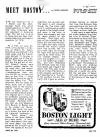| Home Page
Meet Boston Menu
Index
The last horse-car line in Boston was the Marlborough Street line, which ceased operation 1900. At that time, horse-cars were still prevalent in American cities. The last city to stick to horse-cars was New York, where horse-cars continued in operation till 1916. * At 2 P.M. on June 25, 1914, a fire started in a factory on Boston St., Salem. Something was blocked in the water pipes, and the firemen were delayed 15 minutes in getting water out of the hydrants. That delay was fatal and the fire got out of control. Salem’s houses were ancient wooden shacks, for the most part, and several days of hot and dry weather―temperatures were well into the 90’s for at least two days at the time―made them fertile ground for sparks from the factory fire. That afternoon the fire swept the whole south side of Salem, edging close to the business district, reaching within a block of Essex Street, the main business street of Salem. Fire engines sent in from as far as Boston, Lawrence, and Newburyport, failed to check the blaze. Railroad traffic was tied up, and telegrams from Beverly to Boston had to be routed via Maine. Nearly the whole city went up in smoke, but most of the old historical landmarks―the “Witch House," the House of Seven Gables, etc.―were saved. A rumor had it the Salem’s fifty-year old stone depot was either gutted by fire or blown up to check the spread of the conflagration; but no such luck. The depot is still standing, though the fire came right up to it, and burned up plenty of goods in the freight yards; and many is the visitor in Salem who wonders why that old depot should be kept standing. That night, refugees on the northern side of Salem did not miss the electric lights that were missing because the electric power plant had burned; the fire gave more light, all through the night, than had ever been supplied by street lamps. All over Greater Boston, the night was brightly lit in red. Lynn was heated up unbearably; and even Wakefield and Melrose, some ten miles from Salem, got frequent hot blasts with their east winds. And up in New Hampshire, a bright red glow, giving an effect described as a “sunset,” lit the southern horizon that night; and it gave an uncomfortable feeling to realize that, from that distance, they were watching a city burn. At about 9 in the morning, the fire began to burn itself out. It was nearly a week before the smoke ceased rising from the ruins of stricken Salem. Fortunately no more than four lives were lost, though the area devastated was larger than downtown Boston and the Back Bay combined. That area, when finally rebuilt, was so much improved that there is still no difficulty tracing the limits of the burned area of 1914. Public attention, however, was soon diverted from burned Salem. The embers of Salem were still smoking when, on June 28, the assassination of an Austrian archduke set a world into arms. Did the red glow of Salem serve as a warning of the coming of the Age of Blitz?
|
